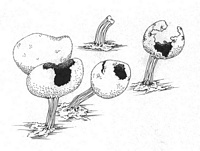|
 Physarum compressum Physarum compressum
SynonymsDidymium radiatum
BiostatusPresent in region - Indigenous. Non endemic
Images (click to enlarge)
Caption: Sporangia of Physarum compressum. The two on the left are about 1.2 mm tall.
Owner: S.L. Stephenson |
Article: Stephenson, S.L. (2003). Myxomycetes of New Zealand. Fungi of New Zealand. Ngā Harore o Aotearoa 3: xiv + 238 p. Hong Kong: Fungal Diversity Press.
Description: Fruiting body a stalked (or less commonly sessile) sporangium, scattered or gregarious, up to 1.5 mm tall. Sporotheca fan shaped, compressed globose, compressed reniform, varying to lobate or plasmodiocarpous, 0.8–1.5 mm in greatest diameter. Stalk, when present, short, stout, sulcate, dark brown or frosted with lime. Hypothallus discoid to irregular, membranous, colourless to dark grey or brown. Peridium consisting of a single layer, thin, calcareous, white or cinereous, squamulose, opening by an apical cleft or irregularly. Capillitium rather loose, consisting of white lime nodes, these variable in size and shape. Spores black in mass, purplish brown by transmitted light, warted, the warts sometimes irregularly distributed, 10.0–12.5 µm in diameter. Plasmodium greyish white.
Habitat: Dead leaves and other types of plant debris.
Distribution: Considered as cosmopolitan by Martin & Alexopoulos (1969) but probably most abundant in the tropics, where it is particularly common in aerial microhabitats. First reported (as Didymium radiatum) from New Zealand by Massee (1892) but without naming a specific locality. Known from Auckland, Coromandel, Nelson, South Canterbury (Lister & Lister 1905), and the Chatham Islands.
Notes: Typical fruitings of this species are easily recognised by the laterally compressed, more or less fan-shaped to reniform sporotheca. However, sessile forms are encountered occasionally, and these are more difficult to identify
|